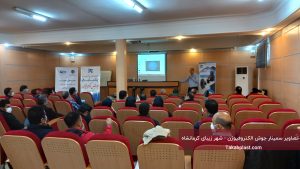History of polyethylene pipes and fittings: Edmund William joined a British company in 1934 and they were working on a project that had been discovered a year earlier, which was a white, solid, waxy substance. This waxy solid was the result of intensive experiments carried out in 1933 at the ICI laboratory by Gisbon and Eric Fast. They heated a mixture of ethylene and benzaloid to 170 degrees Celsius and pressurized it to 1900 atmospheres. But the explosive and unsafe reactions made ICI, which had merged with AkzoNobel of the Netherlands, stop its research.
Faust realized that this research had not continued, so his efforts led to the creation of a scientific society to introduce his and Gibson’s achievements, and in September 1935, Faust’s appearance was recorded in the ICI book (the same company that made fundamental changes in the industry). In a conference attended by prominent scientists, Fast announced that he had made a solid polymer with a molecular weight of about 4000 units from ethylene. But at that time, most people said that ethylene cannot be limerized because the double bond is activated only at a very high temperature.
In December of the same year, William from Michael Perrin College and John Patton researched Gibson and Faust’s experiments with only ethylene. These tests were performed under similar conditions but with better equipment. Under these conditions, the pressure drop was observed and when the reactions were over, 8.5 grams of white polyethylene powder was obtained.
In 1961, William heated a certain substance above its boiling point and it didn’t explode, so he thought there was a problem and left it overnight to cool. The next day, when he looked inside the metal container, he saw something like a mass of sugar, which was not actually sugar, but polyethylene.
In the continuation of the article History of Polyethylene Fittings, the ICI Research Center during World War II worked on the modification of polyethylene and used it in air insulators and in radar equipment. In the early years of the war, the development of this radar was faced with constant problems to insulate the equipment in order to prevent power loss and thus maintain the signal power.
Electrical polyethylene insulating equipment was used in the British Army in order to reduce the weight of radar equipment and used in the radar of warplanes. One of the great advantages of this technology was in long-distance warfare, especially in the war with German submarines. The Germans had to use bulkier materials for their radars, which were less effective.
In 1953, German professor Karl Ziegler found a way to polymerize ethylene at lower pressure and using catalysts. He and his colleagues found that polyethylene allows regular attachment to the surface of particles without the previously high temperature and pressure. The polyethylene produced is much more rigid than the high pressure method.
The American Phillips group worked on polyethylene in the early 1950s and discovered that catalysts with less chromium oxide supported low pressure polymer production. Philips commercialized this product as Marlex.
Polyethylene has come a long way since the explosion experiments of Gibson and Fast, 75 years ago, and new catalysts have created many opportunities for the polymer. Today, a large number of applications, from shopping bags to bulletproof vests, have made a huge change in people’s lives.
The advantages of polyethylene pipes compared to other pipes:
- Lower cost in production and installation as well as easier repairs and transportation and storage
The first installation of gas polyethylene pipes was done in 1959 in Kansas by Phillips. In the mid-1960s, the use of polyethylene pipes gradually replaced steel and cast iron. In 1955, Phillips expanded its operations with butt fusion, and shortly thereafter installed these pipes in oil fields.
In the early 1960s, a medium density, high melt index piping system was proposed. The high melt index made it possible to create manual saddle joints. At that time, it was not possible to use bot fusion on machines below 4 inches, but very quickly Philips 7000 high density production line with low melt index was released to the market and using the machine The devices were connected to the fusion bot and the fusion saddle.
These efforts were initially met with resistance because most officials believed that it was strong, so manufacturers had to sell polyethylene pipes with greater safety. Also, some pipes and fittings of early production were made of gold material, which did not have enough resistance against environmental cracking compared to today’s materials.
Future prospects, manufacturers have no doubt that they can produce polyethylene pipes and fittings that can be used at high pressures. In this article, we have tried to give you some useful and practical tips about the history of polyethylene pipes and fittings, we hope it will be useful.







